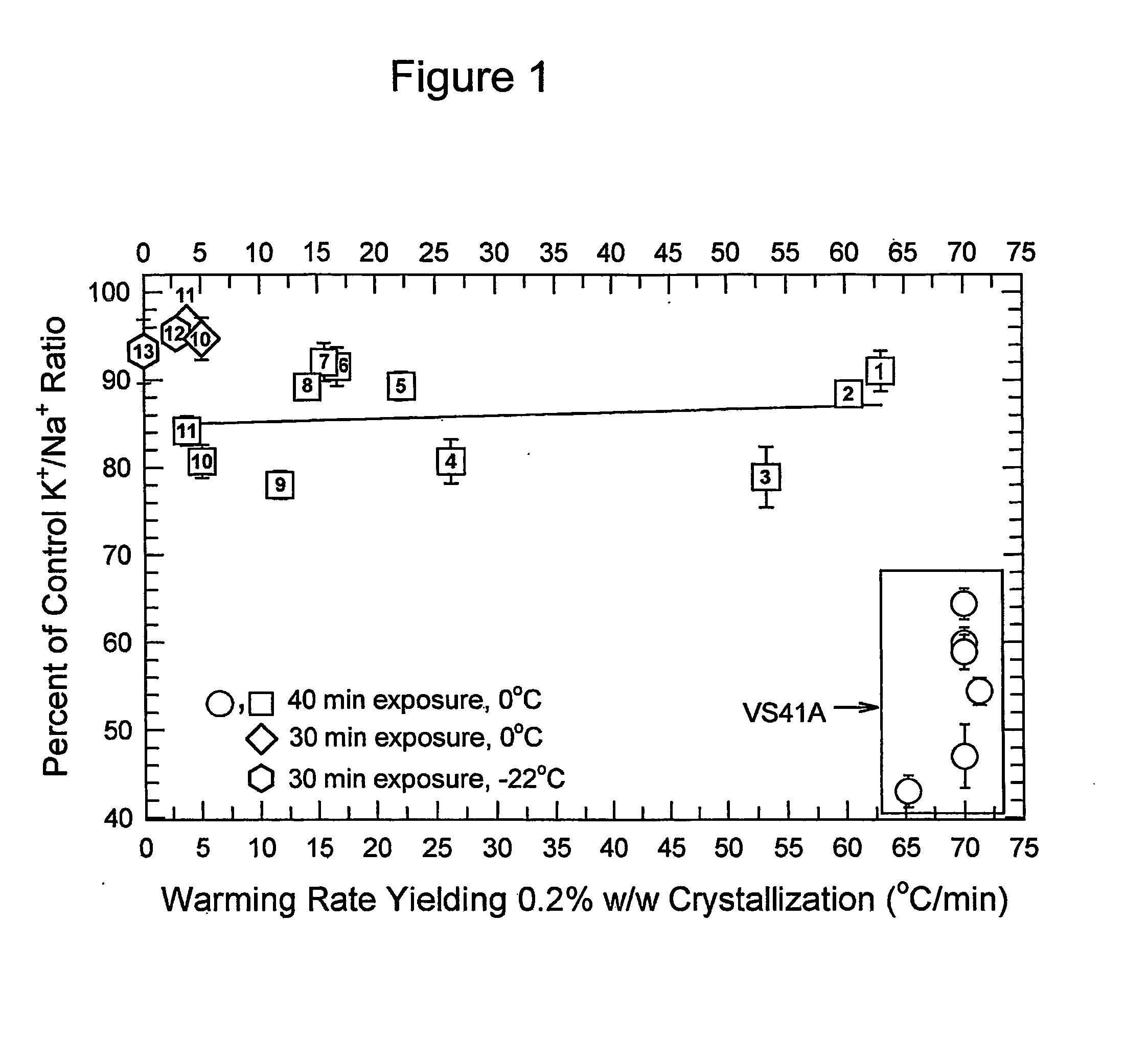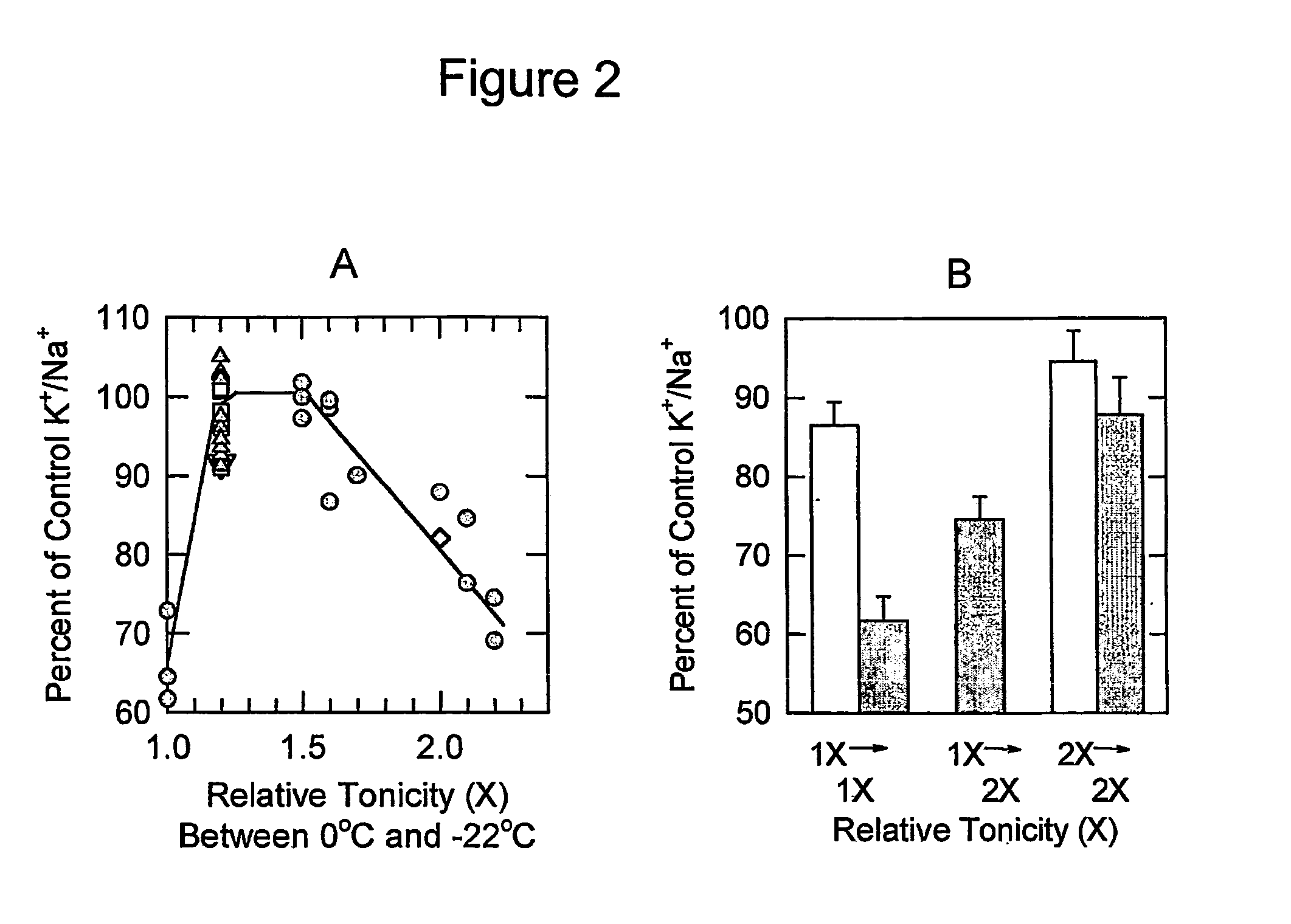Methods and compositions for the cryopreservation of organs
a technology for organs and compositions, applied in the field of compositions and methods for the cryopreservation of organs, can solve the problems of requiring stability, unable to achieve continuous perfusion, and unable to achieve the effect of reversed continuous perfusion protocol,
- Summary
- Abstract
- Description
- Claims
- Application Information
AI Technical Summary
Benefits of technology
Problems solved by technology
Method used
Image
Examples
example 1
M22 and Other Preferred Vitrification Solutions
[0072] Several preferred solutions of utility in the present invention are described in Table 1, and their effects on ice formation and kidney slice viability are described in FIG. 1. In this type of plot, the biological recovery of the system after exposure to a vitrification solution is plotted against the critical warming rate of the tested vitrification solution. In this figure, the critical warming rate was defined as the rate that was sufficient to suppress crystallization of all but 0.2% of the test solution mass, as measured by the mean enthalpy of melting of triplicate samples cooled and warmed in a differential scanning calorimeter (DSC). The numbers inside the plotted symbols refer to the numbers of the corresponding solutions listed in Table 1, except that point 13 refers to data obtained for a new solution, M22, whose formula is provided in Table 2. Viability is assessed using the steady-state K+ / Na+ ratio achieved by the ...
example 2
Method for (1) Safely Cooling Kidneys by Continuous Vascular Perfusion to −20 to −25° C. Without Prior Approximate Osmotic Equilibrium Between the Organ and the Perfusate; (2) Warming by Continuous Vascular Perfusion to a Temperature Above a Temperature Which Permits the Organ to be Perfused, and (3) Perfusing with a Vitrifiable, Unreduced Concentration of Cryoprotectant Containing No Osmotic Buffering Agent
[0075] The design of the first step of a vitrification process that involves perfusion of a vitrification solution such as M22 at a temperature near −22° C. was based in part on background information on chilling injury in rabbit renal cortex (U.S. patent application Ser. No. 09 / 916,032, Hypertonic Reduction of Chilling Injury) as illustrated in FIG. 2. According to the data in FIG. 2A, cooling in the presence of an elevated tonicity can prevent chilling injury in rabbit renal cortical slices virtually entirely, with an optimum tonicity of 1.2-1.5 times isotonic. Table 3 provide...
example 3
Method for Perfusing Organs with a Super-Stable Vitrification Solution and Washing it Out Simultaneously with Warming with Minimal Injury
[0085] The next step was to explore the possibility of perfusing kidneys with M22 in view of its extraordinary stability against ice formation and reasonable toxicity at −22° C. (FIG. 1). However, tissue slice experiments suggested that exposure to M22 at −3° C. would produce unacceptable toxicity, which provisionally ruled out a rewarming procedure like that used for VMP in which it was possible to avoid dilution shock by rewarming prior to dilution.
[0086] Despite the fatality of transitioning from VMP to half-strength VMP+mannitol at −22° C. (50% reduction in molar concentration), the magnitude of the dilution involved in transitioning from M22 to VMP (˜10% reduction in molarity) is much smaller. Therefore, it was first considered that this transition might be tolerable at −22° C. despite the evident hazards of osmotic expansion at this tempera...
PUM
| Property | Measurement | Unit |
|---|---|---|
| temperature | aaaaa | aaaaa |
| temperature | aaaaa | aaaaa |
| temperature | aaaaa | aaaaa |
Abstract
Description
Claims
Application Information
 Login to View More
Login to View More - R&D
- Intellectual Property
- Life Sciences
- Materials
- Tech Scout
- Unparalleled Data Quality
- Higher Quality Content
- 60% Fewer Hallucinations
Browse by: Latest US Patents, China's latest patents, Technical Efficacy Thesaurus, Application Domain, Technology Topic, Popular Technical Reports.
© 2025 PatSnap. All rights reserved.Legal|Privacy policy|Modern Slavery Act Transparency Statement|Sitemap|About US| Contact US: help@patsnap.com



